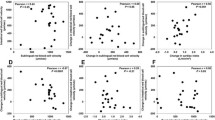Abstract
Impairment of intestinal nutritive perfusion and accumulation of inflammatory cells in the intestinal microvasculature are well-known sequelae of mesenteric ischemia/reperfusion, sepsis, and shock. However, the molecular mechanisms underlying these alterations are still not fully understood. The mouse is particularly suitable for the study of these mechanisms since in this species the involvement of, for example, adhesion receptors or pro-/anti-adhesive mediators can be selectively investigated by the use of monoclonal antibodies or gene-targeted strains. The aim of our present study was, therefore, to establish a model to investigate the microcirculation in the mouse small intestine. Under anesthesia by inhalation of isoflurane-N2O, Balb/c mice (n=16) were laparotomized, and a segment of the jejunum was exteriorized for intravital fluorescence microscopy. Using FITC-dextran (MW 150,000) as a plasma marker, functional capillary density (FCD) of both the intestinal mucosa and muscle layer was analyzed. Nutritive perfusion was homogeneous in both compartments with values for FCD of 512±15 cm-1 in mucosa and 226±21 cm-1 in the muscle layer. No significant changes were observed throughout the observation period of 2 h (FCD values at the end of the observation period: 524±31 cm-1 and 207±7 cm-1 in mucosa and muscle, respectively). Besides capillary perfusion, leukocyte-endothelial cell interaction was analyzed in postcapillary venules of the intestinal submucosa using rhodamine-6G as an in vivo leukocyte stain. Under physiological conditions only a few white blood cells were found rolling along or firmly adherent to the microvascular endothelium (number of rolling leukocytes 1±0.2 cells/mm per second; number of adherent leukocytes: 18±7 cells/mm2). In a separate group rhodamine-6G-labeled syngeneic platelets were infused to analyze platelet-endothelial cell interactions quantitatively in vivo. Platelets rolled along or attached to the endothelium in a manner similar to leukocytes. However, in contrast to leukocytes the interactions were not restricted to venules, but were also observed in small arterioles. The newly established model allows for the visualization and quantitative assessment of both nutritive perfusion and platelet/leukocyteendothelial cell interactions within the distinct layers of the mouse small intestine. Using this model in combination with gene-targeted mice or monoclonal antibodies it is possible to investigate the molecular mechanisms of intestinal inflammation reactions.
Similar content being viewed by others
References
Anthony A, Dhillon AP, Thrasivoulou C, Pounder RE, Wakefield AJ (1995) Pre-ulcerative villous contraction and microvascular occlusion induced by indomethacin in the rat jejunum: a detailed morphological study. Aliment Pharmacol Ther 9:605-613
Arndt H, Bolanowski MA, Granger DN (1996) Role of interleukin 8 on leucocyte endothelial cell adhesion in intestinal inflammation. Gut 38:911-915
Bohlen HG, Gore RW (1977) Comparison of microvascular pressures and diameters in the innervated and denervated rat intestine. Microvasc Res 14:251-264
Boros M, Massberg S, Baranyi L, Okada H, Messmer K (1998) Endothelin-1 induces leukocyte adhesion in submucosal venules of the rat small intestine. Gastroenterology 114:103-114
Boyd AJ, Sherman IA, Saibil FG (1994) Intestinal microcirculation and leukocyte behavior in ischemia-reperfusion injury. Microvasc Res 47:355-368
Bullard DC, Qin L, Lorenzo I, Quinlin WM, Doyle NA, Bosse R, et al (1995) P-selectin/ ICAM-1 double mutant mice: acute emigration of neutrophils into the peritoneum is completely absent but is normal into pulmonary alveoli [see comments]. J Clin Invest 95:1782-1788
Collins CE, Rampton DS (1995) Platelet dysfunction: a new dimension in inflammatory bowel disease. Gut 36:5-8
Collins CE, Rampton DS (1997) Review article: platelets in inflammatory bowel disease- pathogenetic role and therapeutic implications. Aliment Pharmacol Ther 11: 237-247
Fukumura D, Miura S, Kurose I, Higuchi H, Suzuki H, Ebinuma H, et al (1996) IL-1 is an important mediator for microcirculatory changes in endotoxin-induced intestinal mucosal damage. Dig Dis Sci 41:2482-2492
Gonzalez AP, Sepulveda S, Massberg S, Baumeister R, Menger MD (1994) In vivo fluorescence microscopy for the assessment of microvascular reperfusion injury in small bowel transplants in rats. Transplantation 58:403-408
Grassl G, Pummerer CL, Horak I, Neu N (1997) Induction of autoimmune myocarditis in interleukin-2-deficient mice. Circulation 95:1773-1776
Hutter JJ, Mestril R, Tam EK, Sievers RE, Dillmann WH, Wolfe CL (1996) Overexpression of heat shock protein 72 in transgenic mice decreases infarct size in vivo. Circulation 94:1408-1411
Kelly KJ, Williams WW Jr, Colvin RB, Meehan SM, Springer TA, Gutierrez Ramos JC, et al (1996) Intercellular adhesion molecule-1-deficient mice are protected against ischemic renal injury. J Clin Invest 97:1056-1063
Klyscz T, Jünger M, Jung F, Zeintl H (1997) CAP IMAGE: a newly developed computer aided videoframe analysis system for dynamic capillaroscopy. Biomed Tech 42: 168-175
Kuroda T, Shiohara E, Homma T, Furukawa Y, Chiba S (1994) Effects of leukocyte and platelet depletion on ischemia-reperfusion injury to dog pancreas. Gastroenterology 107:1125-1134
Kurose I, Granger DN (1994) Evidence implicating xanthine oxidase and neutrophils in reperfusion-induced microvascular dysfunction. Ann N Y Acad Sci 723:158-179
Ley K, Bullard DC, Arbones ML, Bosse R, Vestweber D, Tedder TF, et al (1995) Sequential contribution of L- and P-selectin to leukocyte rolling in vivo. J Exp Med 181: 669-675
Massberg S, Boros M, Leiderer R, Baranyi L, Okada H, Messmer K (1998) Endothelin- 1-induced mucosal damage in the rat small intestine: role of ETA receptors. Shock 9:177-183
Massberg S, Gonzalez AP, Leiderer R, Menger MD, Messmer K (1998) In vivo assessment of the influence of cold preservation time on microvascular reperfusion injury after experimental small bowel transplantation. Br J Surg 85:127-133
Nolte D, Zeintl H, Steinbauer M, Pickelmann S, Messmer K (1995) Functional capillary density: an indicator of tissue perfusion? Int J Microcirc 15:244-249
Tangelder GJ, Slaaf DW, Arts T, Reneman RS (1988) Wall shear rate in arterioles in vivo: least estimates from platelet velocity profiles. Am J Physiol 254:H1059-H1064
Wakefield AJ, Sankey EA, Dhillon AP, Sawyerr AM, More L, Sim R, et al (1991) Granulomatous vasculitis in Crohn’s disease. Gastroenterology 100:1279-1287
Author information
Authors and Affiliations
Corresponding author
Rights and permissions
About this article
Cite this article
Massberg, S., Eisenmenger, S., Enders, G. et al. Quantitative analysis of small intestinal microcirculation in the mouse. Res. Exp. Med. 198, 23–35 (1998). https://doi.org/10.1007/s004330050086
Received:
Accepted:
Published:
Issue Date:
DOI: https://doi.org/10.1007/s004330050086




